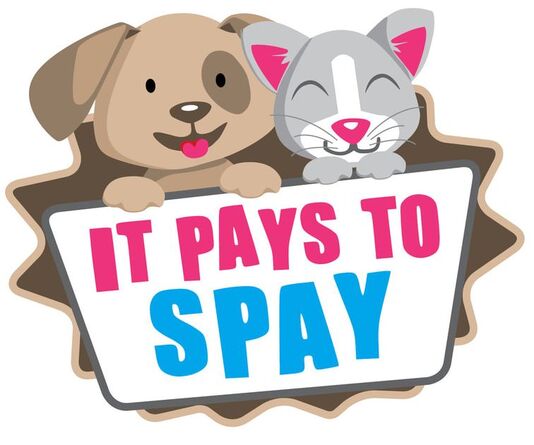Scroll down for Spay/Neuter Application in Spanish
Desplácese hacia abajo para ver la aplicación de esterilización / castración en español
Desplácese hacia abajo para ver la aplicación de esterilización / castración en español
Thank you for SAVING lives by getting your pet spayed or neutered!
How much will it cost to get my dog or cat spayed or neutered?
If you qualify for a "FREE" spay/neuter voucher from LA Animal Services (LAAS) your pet’s spay or neuter is FREE!
If you qualify for a "DISCOUNT" spay/neuter voucher from LA Animal Services (LAAS) there is a co-payment required:
$75 DOG CO-PAYMENT
$40 CAT CO-PAYMENT
Please note, priority is given to applicants who live in the zip code where the mobile clinic takes place.
NOTE: If your application is approved you’ll receive a confirmation email from Luxe Paws with a link to apply for your "FREE" or "DISCOUNT" voucher.
DID YOU KNOW?
FOSTERING SAVES THE LIVES OF HOMELESS PETS
AND...
SPAY/NEUTER SAVES EVEN MORE HOMELESS PETS
How much will it cost to get my dog or cat spayed or neutered?
If you qualify for a "FREE" spay/neuter voucher from LA Animal Services (LAAS) your pet’s spay or neuter is FREE!
If you qualify for a "DISCOUNT" spay/neuter voucher from LA Animal Services (LAAS) there is a co-payment required:
$75 DOG CO-PAYMENT
$40 CAT CO-PAYMENT
Please note, priority is given to applicants who live in the zip code where the mobile clinic takes place.
NOTE: If your application is approved you’ll receive a confirmation email from Luxe Paws with a link to apply for your "FREE" or "DISCOUNT" voucher.
DID YOU KNOW?
FOSTERING SAVES THE LIVES OF HOMELESS PETS
AND...
SPAY/NEUTER SAVES EVEN MORE HOMELESS PETS
Gracias por SALVAR vidas al esterilizar o castrar a su mascota!
¿Cuánto costará esterilizar o castrar a mi perro o gato?
Si califica para un cupón de esterilización/castración "GRATIS" de LA Animal Services (LAAS), ¡la esterilización o castración de su mascota es GRATIS!
Si califica para un cupón de esterilización/castración de "DESCUENTO" de LA Animal Services (LAAS), se requiere un copago:
COPAGO POR PERRO DE $75
COPAGO DE $40 POR CAT
Tenga en cuenta que se da prioridad a los solicitantes que viven en el código postal donde se lleva a cabo la clínica móvil.
NOTA: Si se aprueba su solicitud, recibirá un correo electrónico de confirmación de Luxe Paws con un enlace para solicitar su cupón "GRATIS" o "DESCUENTO".
¿SABÍAS?
LA ACOGIDA SALVA LA VIDA DE MASCOTAS SIN HOGAR
Y...
ESTERILIZAR/CASTRAR SALVA AÚN MÁS MASCOTAS SIN HOGAR
¿Cuánto costará esterilizar o castrar a mi perro o gato?
Si califica para un cupón de esterilización/castración "GRATIS" de LA Animal Services (LAAS), ¡la esterilización o castración de su mascota es GRATIS!
Si califica para un cupón de esterilización/castración de "DESCUENTO" de LA Animal Services (LAAS), se requiere un copago:
COPAGO POR PERRO DE $75
COPAGO DE $40 POR CAT
Tenga en cuenta que se da prioridad a los solicitantes que viven en el código postal donde se lleva a cabo la clínica móvil.
NOTA: Si se aprueba su solicitud, recibirá un correo electrónico de confirmación de Luxe Paws con un enlace para solicitar su cupón "GRATIS" o "DESCUENTO".
¿SABÍAS?
LA ACOGIDA SALVA LA VIDA DE MASCOTAS SIN HOGAR
Y...
ESTERILIZAR/CASTRAR SALVA AÚN MÁS MASCOTAS SIN HOGAR
Scroll down for Spay/Neuter Application in Spanish
Desplácese hacia abajo para ver la aplicación de esterilización / castración en español
Desplácese hacia abajo para ver la aplicación de esterilización / castración en español
|
|
Please scroll down for the waiver/consent form!
|
|
Please scroll down for the waiver/consent form!
Stray Paws Animal Haven Waiver/Consent Form
Please download the consent form below and bring it with you the day of the event.
| Stray Paws Animal Haven Consent Form - English | |
| File Size: | 99 kb |
| File Type: | |
| Stray Paws Animal Haven Consent Form - Spanish | |
| File Size: | 118 kb |
| File Type: | |
Your browser does not support viewing this document. Click here to download the document.
Your browser does not support viewing this document. Click here to download the document.
(Humane Society International)
The implementation of sustainable spay and neuter programs is one of the critical elements in addressing canine and feline populations that have exceeded the capacity of the local community to adequately care for them.
Reasons to spay/neuter animals
Spay/neuter benefits animals and the communities in which they live.
Spay/neuter slows population growth
Without spay and neuter initiatives, homeless animals are often euthanized, neglected or die of disease. Sterilization is critical for management of free-roaming dogs and cats and related disease control concerns. When effectively delivered and combined with vaccinations, spay/neuter provides a humane and effective way to reduce the number of animals living on the streets, and improves the health of those remaining. Sterilizing community dogs and returning them to their territories on the streets allows for a natural reduction in their population over time and leaves the most socialized dogs on the streets. We have found that the public views these sterilized and vaccinated dogs (identifiable via an ear notch or other marking) more favorably and the human-dog interaction improves Sterilizing pets prevents them from contributing to the problem of homeless or abandoned dogs and cats.
Spay/neuter curbs undesirable hormone-related behaviors
Females no longer have a heat cycle; this eliminates the attraction and approach of unwanted attention by male dogs.
Roaming is greatly reduced; male dogs, especially those used for security, are less likely to wander off an owner’s property if they do not have the hormone drive to pursue a female in heat. This way, they can better serve as watchdogs, may not need to be tied up, and are less likely to contract disease or suffer injury. Neutered dogs may actually be more protective, as they no longer are distracted by the temptations of breeding with females or fighting with other males.
Spraying and marking in males is reduced.
Spay/neuter reduces health risks for the animals themselves. There are a number of potentially fatal health conditions and transmissible diseases that animals can contract or develop as a result of being intact and breeding; for example, pyometra, TVT, and reproductive cancers. These risks are eliminated when the animal is spayed or neutered. On the whole, animals who have been sterilized at an early age tend to live longer, healthier lives, potentially increasing their lifespans by an average of one to three years for dogs, and three to five years for cats.
The implementation of sustainable spay and neuter programs is one of the critical elements in addressing canine and feline populations that have exceeded the capacity of the local community to adequately care for them.
Reasons to spay/neuter animals
Spay/neuter benefits animals and the communities in which they live.
Spay/neuter slows population growth
Without spay and neuter initiatives, homeless animals are often euthanized, neglected or die of disease. Sterilization is critical for management of free-roaming dogs and cats and related disease control concerns. When effectively delivered and combined with vaccinations, spay/neuter provides a humane and effective way to reduce the number of animals living on the streets, and improves the health of those remaining. Sterilizing community dogs and returning them to their territories on the streets allows for a natural reduction in their population over time and leaves the most socialized dogs on the streets. We have found that the public views these sterilized and vaccinated dogs (identifiable via an ear notch or other marking) more favorably and the human-dog interaction improves Sterilizing pets prevents them from contributing to the problem of homeless or abandoned dogs and cats.
Spay/neuter curbs undesirable hormone-related behaviors
Females no longer have a heat cycle; this eliminates the attraction and approach of unwanted attention by male dogs.
Roaming is greatly reduced; male dogs, especially those used for security, are less likely to wander off an owner’s property if they do not have the hormone drive to pursue a female in heat. This way, they can better serve as watchdogs, may not need to be tied up, and are less likely to contract disease or suffer injury. Neutered dogs may actually be more protective, as they no longer are distracted by the temptations of breeding with females or fighting with other males.
Spraying and marking in males is reduced.
Spay/neuter reduces health risks for the animals themselves. There are a number of potentially fatal health conditions and transmissible diseases that animals can contract or develop as a result of being intact and breeding; for example, pyometra, TVT, and reproductive cancers. These risks are eliminated when the animal is spayed or neutered. On the whole, animals who have been sterilized at an early age tend to live longer, healthier lives, potentially increasing their lifespans by an average of one to three years for dogs, and three to five years for cats.











